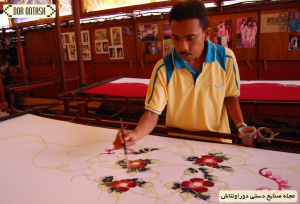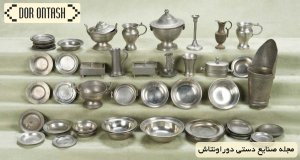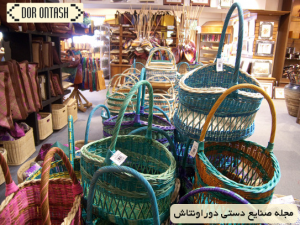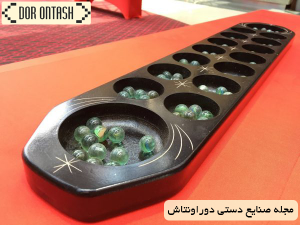Malaysian handicrafts have many items due to its historical context and of course the presence of different ethnic groups with different beliefs and cultures. Malaysia is a real Asia. In fact, almost everything that exists in Asia can be found in this country, because the population of this country mainly consists of three groups of Malays, Chinese and Hindus, and the diversity of Malaysian handicrafts is a combination of the arts of these countries.
This article will help you get acquainted with the souvenirs of Malaysia and have a good souvenir of your trip to this country.
Related link: iran handicrafts
History of Malaysian handicrafts
The Federation of Malaysia is located in the north of the Strait of Malacca, between the countries of Thailand and Indonesia, and at the intersection of the two Indian and Pacific Oceans. The area of this country is about 310 thousand square kilometers, 75% of which is covered by dense forests. Due to the abundant rain (about 1,800 mm per year), the trees often reach up to 40 meters (130 feet) in height. Perhaps for this reason and as a result of severe soil erosion, its agricultural lands are relatively weak and do not have the desired yield. The most important product of Malaysia is natural rubber, which is one of the resins, and this country is the largest exporter of it in the world.
After that, due to the existence of vast palm (palm) forests, the export of palm oil, which is used for food, is considered one of the most important sources of foreign exchange income of the country. The most important mineral in Malaysia is tin, and this country has achieved the first position in terms of its export. Malaysia’s industrial development program has been very successful over the past 25 years, so that this country is in the process of leaving the group of third world countries.
Population of Malaysia
The population of Malaysia is about 30 million people, with the native population (Malays) together with Chinese, Indian, Thai and Arab immigrants forming a mixed race. The official language is Malay, which with a slight difference in some words is the same as the language of the people of Indonesia and Brunei, and it is written in Latin script. The official religion of the country is Islam, but other ethnic minorities follow other religions. Due to being on the sea route of Europe to China and Japan through the Strait of Malacca, Malaysia has been constantly attacked by foreign powers, so that since the beginning of the 16th century, there have been various attacks on this land.
All kinds of Malaysian souvenirs and handicrafts
1) Bajo Kebaya Baju Kebaya
Bajo kebaya is a traditional women’s dress for Malaysian women, which can be a good option for souvenirs. These clothes have different colors, designs, quality and sizes and you can buy one according to your taste.
2) metal products Pewter Goods
Among other popular souvenirs of Malaysia are metal containers; Metal containers that are often a combination of tin and lead. You have a lot of choice when buying these dishes because they have different types and each one is made with a unique design.
3) colorful handwovens Hand Woven Crafts
If you are looking to buy handicrafts as a souvenir, this is for you. In Malaysia, using bamboo wood, coconut shell and pandan leaves, they artistically weave items such as handbags, beautiful colorful bags and baskets. You can use small bags as a wallet and prepare a pure and memorable gift from your trip
Related link: Wicker products
4) traditional toffee
Your trip to Malaysia is not complete unless you try Dodol sweet toffees. These toffees are sweet and originally brown, but in recent years they have been produced in other colors.
These delicious foods have a strange flavor that is a very interesting experience to try. These delicious toffees are sold in packages of various sizes in most stores in this country.
5) Colorful Malaysian fabrics
As we mentioned, fabric is one of the most basic souvenirs of Malaysia, in this section we will introduce some important and prominent fabrics of this country:
Songket: Songket is one of the main souvenirs of Malaysia, it is actually specific to the state of Kelantan in this country. Sangat is a kind of unique and special fabric in which silk and gold are used.
This fabric was produced around the 12th century AD due to trade between India, Malaysia and China. However, it is not surprising that sangat is one of the most expensive souvenirs in Malaysia.
combo:
Kumbu (Pua Kumbu) is the name of a type of Malaysian fabric that is produced in beautiful colors and designs, the main material of these fabrics is cotton and it has a rough material, it can even be used as a blanket and cover in the fall season. used cloth
By buying Kumbao, you will learn more about the art of Malaysian people. In the past, cotton fabrics were used to cover religious leaders and were considered a kind of ceremonial fabric.
Batik: Batik (Malaysian Batik) is a special type of fabric of Malaysia which is prepared by combining silk and cotton, these fabrics are designed and beautified using wax and various colors. Most batiks have flowers, birds or butterflies and they are used to decorate and make clothes more beautiful.
You can also buy batik scarves and blouses, which are sold at more reasonable prices, for example, you can get a blouse for 38 thousand tomans.
Krugsang is a type of brooch that Malay women use and they often choose them in harmony with their ornaments and jewelry or prepare three different sizes of these brooches and install them together on their clothes. You can attach these pins to your Baju Kebaya and become an authentic Malaysian.
7) Labo Sayong Labu Sayong
Labo Sayong is a container usually made of glass or earthenware similar to the design of a pumpkin, which is often black and white in color.
These containers are used to store water and are considered one of the main handicrafts in Malaysia. Labo Siangs keep water somewhat cool in hot weather.
8) Decorated slippers Beaded Slippers
Colorful and beautified slippers with pearls and eye-catching flower embroideries are authentic souvenirs of Malaysia. Most of these slippers have beautiful designs of flowers, birds and animals.
9) The traditional game of Kong Kak Congkak
The population of Malaysia consists of Chinese, Malaysian and Indian ethnic groups, therefore it has different customs and traditions. One of the symbols of the ancients living in Malaysia is the traditional game of Kong Kak.
This game requires two players and is often played at home. The appearance of the game is simple, but you should benefit from special tactics and skills to be able to win the field.
The traditional game of Kong Cock has a board with between 6 and 10 holes on each of them in two rows, with a larger hole placed at the end of each row. For this game, they use pebbles, pieces of wood or marbles.
10) hair clip Cucuk Sanggul
One of the special decorative items in Malaysia is a hair clip known as Cucuk Sanggul. This hair clip is often made with gold and silver and is given as a gift to the bride in the wedding ceremony and she decorates her hair with this clip.
The appearance of this clamp is long and narrow, and one side has an engraved image of the symbol of ancient myths or flowers and birds. In the olden days, when Malay women were going to pass through unsafe places at night, they put this clip on their hair so that if someone dared to touch them, they could defend themselves, but today this clip is used in designs and styles. Differently made to become one of the best souvenirs of Malaysia.
The most important fields of handicrafts in Malaysia:
1- Batik:

In fact, Malaysia should be considered the cradle of batik industry. In such a way that this term was directly transferred from Malayalam to other languages and that dyeing method is the way of reserving or waxing the parts of the fabric that should not absorb the dye solution. In general, batik is done in two ways: molding and painting with the help of a brush. In the mold method, designs and motifs are first transferred to special molds made of tin, and then these sheets are connected to wooden handles. In order to increase the speed of work, the hands will not be hurt. Batik with the help of a brush is the same painting on fabric that is done by reserving or coating parts of it with wax, and compared to the mold, it creates more freedom of action for artisans and artists, and as a result, many different designs and patterns can be created. created on the cloth. In this type of batik, the working method is exactly the same as that of mold batik, in that after drawing the designs with a brush with colors dipped in wax, it is again covered with a thick layer of wax. stabilize After the wax dries, it is washed with boiling water to remove the wax compounds. After the fabric dries, it is done again using a template or with the help of a brush to create other patterns and colors on the desired fabric in the same order. The number of patterns and colors used in exceptional works reaches 14 types, in such a way that the steps of reserving, dyeing and washing are repeated 14 times for a piece of fabric. The main batik printing centers are in the states of Terengganu and Selangor, in Terengganu they use the painting method and in Selangor they use the mold for batik printing.
2- Zari Bafi:
This field of handicrafts also has a relatively long history in Malaysia, which was most likely brought there from Iran and through India. As mentioned, Indian and Iranian merchants have been in commercial relations with Malaya and the islands of Java and Sumatra (now Indonesia) since the 12th and 13th centuries AD, and used various techniques, including gold weaving, whose history in Iran dates back to the Sassanid period. They have spread there.
This type of fabric, which is woven using very thin threads in the form of gold and silver threads as the weft, along with silk fibers as the warp thread or chele, with the help of advanced hand looms, is very expensive, and for this reason, the clothes Made of zari cloth, it is usually used in celebrations and big parties. In addition, this fabric is also used in making decorative items and all kinds of bags and shoes.
The designs used in the fabric of zari fabric are often flower and plant patterns and in some cases, images of mythological heroes. The main production centers are located in the states of Terengganu, Selangor and Kuala Lumpur.
3- Cotton fabric texture:
Women’s clothes are woven using very fine cotton threads. Usually, this fabric is used for batik printing, and the common motifs include native birds, fish and aquatic species of the Malaysian coast, which have many fans in foreign countries in their beautiful and artistic coloring. Previously, simple cotton fabrics were also produced to meet the current needs of life. which today is faced with the competition of large textile factories, and due to its non-specialty and non-artistic nature, there is no justification for continuing its production.
4. Metalworking and jewelry making:
Making various objects using copper, brass and alloy and painting on them is one of the valuable handicrafts of Malaysia, outstanding examples of its past works are kept in the museums of the states of Terengganu, Selangor and Kuala Lumpur. The products include trays, tea sets, chocolate bars, and pots and pans. Tapestry making using very thin silver strings or wires with good quality is also common in Malaysia. In addition, while using different metals such as gold, silver and bronze, various kinds of jewelry are made, which are very popular all over the world due to the originality of the designs. The resulting products include necklaces, rings, bracelets, brooches, belts, earrings and the like.
5- Rory wood carving:
Due to the favorable weather conditions, the presence of large forest areas has made it very easy for Malaysian artisans and artists to access all kinds of industrial wood. Of course, wood is mostly used for the interior decoration of mosques and cultural buildings, and making various consumer objects from wood is less common in Malaysia like in India.
6- Basket and mat weaving:
From all kinds of plant fibers such as rice stalks, reeds, and especially bamboo, which are abundantly found there due to the warm and tropical climate of Malaysia, various consumer and decorative products including baskets, mats, special fishing traps in the sea. they leave, dishes and even furniture are prepared. From lower types of vegetable fibers, resistant ropes for packing and moving heavy loads and even very strong ropes, especially for anchoring ships, are produced. Of course, the competition of plastic fibers in recent years has severely damaged this field of handicrafts in Malaysia. However, the naturalness of the materials used in the baskets and mats of the first type has attracted a lot of attention for consumers and has given it a kind of decorative effect. Besides, it is of great value for foreign tourists who visit Malaysia and also for the export market in Europe and America.
7- Carving and painting on shells:
In Malaysia, by using oysters obtained from the coasts of that country and performing various operations on it in the form of cutting, carving, painting and coloring, various flowers and paintings with aquatic images are made, which have a special beauty. In some cases, decorative curtains are made by connecting pieces of colored shells, especially for installation in hotels and public places.
8- Carpet weaving:
This field of production, which is usually done using cotton threads, is not comparable to other common fields of handicrafts in terms of evolution and progress, and it is mostly in the form of zilo weaving, which is mainly consumed locally and used as rugs. take
9- Making dolls with local clothes:
The production of all kinds of dolls using wood and batik fabric, which represents the native culture of the Malaya archipelago, has been greatly promoted due to the reception of tourists in recent years. Other crafts that can be mentioned in Malaysia include ceramic making, various types of embroidery such as needlework and crocheting, making decorative and sun umbrellas, fans and various masks that are used in celebrations and festivals.
Organizations responsible for Malaysian handicrafts
In Malaysia, there is a specialized organization for the revival and promotion of handicrafts called the Malaysian Handicrafts Development Company, which in addition to planning and implementing various educational and production projects, in recent years two handicraft complexes: one in the capital of this country and the other in the island of Langkawi opened. In addition, the Ministry of Culture, Arts and Tourism, considering the cultural and economic importance of handicrafts, through holding an annual festival for two weeks throughout the country, provides a favorable environment for the supply of the best products and the selection and introduction of the selected artisans and artists of the year. .




